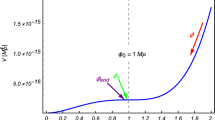Abstract.
Within the framework of an explicit dynamical model, in which we calculate the radiatively-corrected, tree-level potential that sets up inflation, we show that the inflaton can be a significant part of dark matter today. We exhibit potentials with both a maximum and a minimum. Using the calculated position of the potential minimum, and an estimate for fluctuations of the inflaton field in the early universe, we calculate a contribution to the matter energy density of \((1-2)\times 10^{-47}{\rm GeV}^4\) in the present universe, from cold inflatons with mass of about \(6\times 10^9 {\rm GeV}\). We show that the inflaton might decay in a specific way, and we calculate a possible lifetime that is several orders of magnitude greater than the present age of the universe. Inflaton decay is related to an interaction which, together with a spontaneous breakdown of CP invariance at a cosmological energy scale, can give rise to a neutrino-antineutrino asymmetry just prior to the time of electroweak symmetry breaking.
Similar content being viewed by others
Explore related subjects
Discover the latest articles and news from researchers in related subjects, suggested using machine learning.Author information
Authors and Affiliations
Additional information
Received: 26 November 1997 / Revised version: 8 December 1997 / Published online: 24 March 1998
Rights and permissions
About this article
Cite this article
Barshay, S., Kreyerhoff, G. The inflaton as dark matter. Eur. Phys. J. C 5, 369–376 (1998). https://doi.org/10.1007/s100529800842
Issue Date:
DOI: https://doi.org/10.1007/s100529800842



